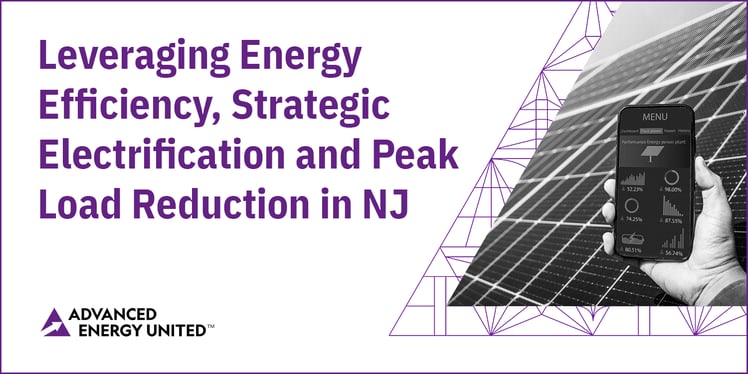 How quickly and efficiently New Jersey can transition to a 100% clean energy future depends in no small part on how the state’s utilities implement energy efficiency and demand management guidance recently issued by New Jersey’s Board of Public Utilities (BPU). At the end of July, the BPU voted 4-0 to approve an Order that largely implements Staff’s Straw Proposals on the 2nd Triennium of Energy Efficiency and Peak Demand Reduction Programs (Triennium 2), an every-three-year regulatory proceeding that defines the scope of utility demand side management programs. Triennium 2 has the potential to foster economic development in New Jersey, increase grid reliability and flexibility, and lower utility bills for residents by leveraging advanced energy technologies and services. However, the promise of these programs is in the hands of the state’s utilities. The NJ BPU designed Triennium 2 in a way that provides utilities with significant leeway to determine how aggressively and ambitiously to implement these programs. To maximize the guidance in this Order, utilities should make significant investments in the three areas covered by Triennium 2: electricity reduction measures, building decarbonization programs, and peak load demand-response initiatives.
How quickly and efficiently New Jersey can transition to a 100% clean energy future depends in no small part on how the state’s utilities implement energy efficiency and demand management guidance recently issued by New Jersey’s Board of Public Utilities (BPU). At the end of July, the BPU voted 4-0 to approve an Order that largely implements Staff’s Straw Proposals on the 2nd Triennium of Energy Efficiency and Peak Demand Reduction Programs (Triennium 2), an every-three-year regulatory proceeding that defines the scope of utility demand side management programs. Triennium 2 has the potential to foster economic development in New Jersey, increase grid reliability and flexibility, and lower utility bills for residents by leveraging advanced energy technologies and services. However, the promise of these programs is in the hands of the state’s utilities. The NJ BPU designed Triennium 2 in a way that provides utilities with significant leeway to determine how aggressively and ambitiously to implement these programs. To maximize the guidance in this Order, utilities should make significant investments in the three areas covered by Triennium 2: electricity reduction measures, building decarbonization programs, and peak load demand-response initiatives.
In the coming transition to renewable energy and electric transportation, the state will experience significant electric load growth that will require further investments in the transmission and distribution (T&D) systems. Aggressive deployment of technologies to increase energy efficiency, add demand flexibility, and reduce peak demand will help integrate high levels of renewable generation and maintain system affordability and reliability. In order to reduce the magnitude of those T&D infrastructure investments, New Jersey should aim to significantly exceed the statutory targets to reduce electricity use by 2% per year and gas use by 0.75% per year. A more aggressive implementation strategy by the utilities would help cut emissions and could lower monthly customer energy expenses. The Board and the utilities should consider this as Triennium 2 programs are filed and reviewed.
New to Triennium 2, the Board has tasked the utilities with proposing building decarbonization “start-up” programs to make progress towards the goals set forth by Governor Murphy in Executive Order 316, which sets targets to electrify 400,000 residential and 20,000 commercial buildings by the end of 2030. The start-up programs are also intended to help the utilities gain experience in, and help the state evaluate questions around program design, measurement and verification, workforce development, cost-effectiveness, and performance incentives. Though gas utilities are not required to propose building decarbonization programs, we hope that they consider piloting thermal energy networks under this framework.
The Triennium 2 order also establishes a long-awaited framework for demand response programs that are critical to enhancing demand flexibility and incentivizing customers to reduce usage during peak demand hours. This capability will become increasingly valuable as the energy transition proceeds. We were particularly pleased to see the BPU’s emphasis on leveraging the competitive market, since third-party providers of demand response technologies and services are uniquely qualified to work with customers to maximize demand response potential and cost effectiveness.
The Board and Staff, through Triennium 2, are advancing critical components of the 2018 Clean Energy Act (CEA) and the Energy Master Plan (EMP), including energy use and peak demand reduction measures that are accessible to all communities across the state. The Triennium 2 framework builds on the energy efficiency programs of Triennium 1 by including building electrification and demand response. Working together these three strategies can reduce energy bills, alleviate pressure on the already-strained grid and mitigate the need for new infrastructure to meet peak load, which is the primary driver of utility distribution costs. Together these measures will give customers additional opportunities to manage energy use and costs, reduce greenhouse gas emissions, and support a more reliable, resilient and flexible grid.
As Governor Murphy often remarks, “the ball is now in your court.” In this case, it’s in the court of the utilities, who will decide how many cost-saving opportunities are provided to the households and businesses in New Jersey and how valuable those opportunities are. As utility proposals are filed by the October 2 deadline, we hope that the Board will carefully scrutinize them to ensure that they match the ambition of the CEA, EMP, and Executive Orders 315 to 317, which sets New Jersey on a path to utilizing 100% renewable electricity.